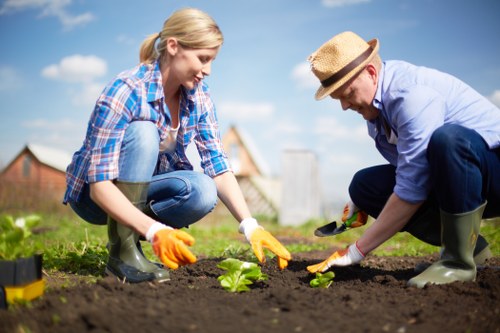Lawn Turf Installation Harefield: Transform Your Outdoor Space

Transforming your outdoor space begins with a lush, green lawn. In Harefield, lawn turf installation has become a popular choice for homeowners looking to enhance the beauty and functionality of their gardens. Whether you're aiming for a vibrant green carpet for your children to play on or a serene space for relaxation, professional turf installation can make all the difference.
Choosing the right turf and ensuring proper installation are crucial steps in achieving a long-lasting and beautiful lawn. This article delves into the essentials of lawn turf installation in Harefield, guiding you through the process and highlighting the benefits of a professionally installed turf.
Understanding the importance of a well-installed lawn can help you make informed decisions about your garden. A healthy turf not only boosts your property’s aesthetic appeal but also provides environmental benefits such as improved air quality and reduced soil erosion.
Benefits of a Well-Installed Lawn

A meticulously installed lawn offers numerous advantages. Firstly, it enhances the overall appearance of your property, making it more attractive to visitors and potential buyers. A green, healthy lawn can significantly increase your home's curb appeal.
Secondly, a good lawn provides a perfect space for outdoor activities. Whether it’s for family gatherings, picnics, or simply enjoying a sunny day, a well-kept turf offers a comfortable and inviting area.
Moreover, a healthy lawn contributes to environmental sustainability. It acts as a natural air filter, absorbing carbon dioxide and releasing oxygen. Additionally, it helps in retaining soil moisture, reducing the risk of erosion during heavy rains.
Environmental Benefits

The environmental impact of a healthy lawn cannot be overstated. Turf grass plays a vital role in maintaining ecological balance. It supports local biodiversity by providing habitats for various insects and small animals.
Furthermore, a well-maintained lawn can help in managing urban heat islands. Grass and soil surface lower the ambient temperature, making your surroundings cooler and more comfortable during hot weather.
Lastly, lawns contribute to noise reduction. The grass blades absorb sound, creating a quieter and more peaceful environment around your home.
Preparing Your Lawn for Turf Installation

Proper preparation is key to successful turf installation. Start by clearing the area of any debris, weeds, or existing grass. This ensures that the new turf has a clean surface to establish roots.
Next, assess the soil quality. Soil that is compacted or lacks nutrients can hinder turf growth. It’s essential to aerate the soil and incorporate organic matter to improve its structure and fertility.
Leveling the ground is another critical step. Uneven surfaces can lead to water pooling, which may cause turf damage. Use a rake to create a smooth, flat surface before laying the turf.
Soil Preparation

Soil preparation involves more than just removing obstacles. It requires understanding the type of soil in your garden. Clay soils, for instance, retain water but can become hard and compacted, while sandy soils drain quickly but may lack essential nutrients.
To optimize soil health, consider conducting a soil test. This will help you determine the pH level and nutrient content, allowing you to make necessary amendments for optimal turf growth.
Additionally, improving soil aeration facilitates better root penetration and nutrient uptake. This can be achieved through techniques such as tilling or using specialized tools to create air pockets in the soil.
Steps for Installing Lawn Turf

Installing lawn turf involves several steps to ensure a successful outcome. Here’s a step-by-step guide to help you through the process:
- Planning and Measuring: Determine the area where you want to lay the turf. Accurate measurements help in purchasing the right amount of turf and avoid wastage.
- Soil Preparation: As discussed, prepare the soil by removing debris, aerating, and leveling the ground.
- Applying a Weed Barrier: Place a weed barrier to prevent future weed growth, ensuring the turf remains healthy and free from unwanted plants.
- Laying the Turf: Start laying the turf from one corner, ensuring each piece is tightly fitted against the next to avoid gaps.
- Seaming and Trimming: Carefully seam the edges and trim any excess turf to fit the designated area perfectly.
- Watering: Water the freshly laid turf thoroughly to help the roots establish and the grass to settle into the soil.
- Maintenance: Follow a regular maintenance schedule to keep your lawn healthy and vibrant.
Each step requires attention to detail to ensure the turf integrates well with your garden and thrives in the Harefield climate.
Laying Techniques

Proper laying techniques are essential for a seamless and durable lawn. Begin by laying the turf in a staggered pattern, similar to laying bricks. This helps in creating a more natural look and avoids visible seams.
Ensure that the turf is pressed firmly into the soil to eliminate air pockets and promote good contact between the roots and the soil. Rolling the turf after laying can help in achieving a flat and even surface.
Avoid overlapping or leaving large gaps between turf pieces, as this can lead to uneven growth and increase the risk of weed infestation.
Maintaining Your New Lawn Turf

Maintenance is crucial for the longevity and health of your turf. Regular watering is necessary, especially in the initial weeks after installation. Ensure the soil remains moist but not waterlogged.
Grading the lawn helps in preventing water accumulation and facilitates proper drainage. Regular mowing is also important to encourage dense growth and prevent the grass from becoming too long.
Fertilizing your lawn provides the essential nutrients needed for healthy growth. Choose a fertilizer suitable for your turf type and follow the recommended application schedule.
Effective Lawn Care Tips

Effective lawn care goes beyond basic maintenance. Aerate your lawn periodically to relieve soil compaction and improve root growth. This involves creating small holes in the soil to allow air, water, and nutrients to reach the roots.
Addressing pest and disease issues promptly is also vital. Regularly inspect your lawn for signs of pests or diseases and take necessary actions to control them.
Implementing a proper irrigation system can help in maintaining consistent moisture levels, reducing the need for manual watering and ensuring even distribution of water across your lawn.
Choosing the Right Turf for Harefield’s Climate

Harefield’s climate plays a significant role in determining the best type of turf for your lawn. Opt for turf varieties that are well-suited to the local weather conditions to ensure optimal growth and resilience.
Warm-season grasses like Bermuda or Zoysia thrive in Harefield’s summer heat, while cool-season grasses such as Ryegrass or Fescue perform well during the colder months.
Consider factors like sunlight exposure, soil type, and water availability when selecting your turf. Consulting with a local turf installation expert can help you make an informed choice.
Best Turf Types for Harefield

Choosing the best turf type involves understanding your specific needs and the environmental conditions of Harefield. Here are some popular options:
- Bermuda Grass: Ideal for sunny areas, highly durable, and drought-resistant.
- Ryegrass: Quick to establish, excellent for overseeding, and provides a lush green appearance.
- Fescue: Tolerates shade well, requires less water, and is resistant to pests.
- Zoysia: Dense growth, excellent wear tolerance, and good for both sunny and partially shaded areas.
- Kentucky Bluegrass: Offers a rich green color, good for cooler climates, and establishes a strong root system.
Selecting the right turf variety ensures your lawn remains healthy and beautiful throughout the year.
Common Mistakes to Avoid

While installing lawn turf may seem straightforward, avoiding common mistakes can save you time and effort in the long run. One common error is neglecting proper soil preparation, which can lead to poor turf establishment and increased susceptibility to weeds.
Another mistake is inadequate watering. Overwatering or underwatering can damage the turf and hinder its growth. It’s essential to find the right balance to keep the grass healthy.
Failing to choose the appropriate turf type for your specific conditions can also result in a lawn that doesn’t thrive. Ensure you select a variety that matches your climate, soil, and sunlight exposure.
Avoiding Installation Pitfalls

To avoid installation pitfalls, follow best practices meticulously. Start by measuring the area accurately to purchase the right amount of turf. Overestimating can lead to unnecessary expenses, while underestimating can cause shortages.
When laying the turf, avoid stretching or pulling it too tightly. This can cause the grass to become damaged and create unsightly bends and wrinkles.
Lastly, avoid walking on the newly laid turf until it has fully established. This prevents compaction and allows the roots to grow deeply into the soil.
Cost of Lawn Turf Installation in Harefield

The cost of lawn turf installation in Harefield varies based on several factors, including the size of the area, the type of turf selected, and the complexity of the installation process.
On average, you can expect to pay between £5 to £10 per square meter for turf installation. This includes the cost of turf, preparation, and laying. Additional services like soil testing, fertilization, and irrigation systems can increase the overall cost.
Investing in high-quality turf and professional installation can lead to long-term savings by reducing maintenance costs and extending the lifespan of your lawn.
Budgeting for Your Lawn Project

When budgeting for your lawn turf installation, consider all potential expenses. This includes the cost of turf, soil amendments, weed barriers, and any necessary tools or equipment.
Hiring a professional turf installation service may seem more expensive initially, but it ensures quality work and long-term durability. Compare quotes from different providers to find the best value for your investment.
Additionally, factor in ongoing maintenance costs such as watering, mowing, and fertilizing to keep your lawn in top condition.
Why Hire Professionals for Turf Installation

While it’s possible to lay turf yourself, hiring professionals can provide numerous benefits. Experienced turf installers have the knowledge and expertise to ensure the job is done correctly, leading to a healthier and more resilient lawn.
Professionals use specialized tools and techniques to prepare the soil, lay the turf evenly, and ensure proper drainage. This attention to detail results in a superior finish and reduces the likelihood of future problems.
Moreover, professional installers often offer warranties and follow-up services, giving you peace of mind and support in maintaining your lawn.
Expertise and Efficiency

Professional turf installers bring a level of expertise that ensures your lawn is installed efficiently and effectively. Their experience allows them to anticipate and address potential issues before they become significant problems.
Their familiarity with local conditions and turf varieties means they can recommend the best options for your specific needs, ensuring optimal growth and durability.
Additionally, professionals save you time and effort, handling all aspects of the installation process so you can enjoy your new lawn without the hassle.
Nearby Areas for Turf Installation Services

Harefield is surrounded by several nearby areas that also benefit from top-notch lawn turf installation services. These areas include:
- Hillingdon Just a short distance away, Hillingdon offers a variety of turf options suited to different garden sizes and styles.
- Chiswick Known for its vibrant community, Chiswick homeowners often seek high-quality turf installation for their picturesque gardens.
- Uxbridge Uxbridge residents appreciate durable and low-maintenance turf varieties that complement their suburban homes.
- Yiewsley Yiewsley’s mix of modern and traditional gardens benefits from professional turf installation services.
- Ruislip In Ruislip, turf installers specialize in creating expansive lawns and lush green spaces for families.
- Pinner Pinner offers a range of turf types, catering to both small patios and large backyards.
- Denham: Denham’s scenic landscapes are enhanced by expertly installed turf that blends seamlessly with the natural surroundings.
- Colnbrook: Colnbrook homeowners value resilient turf options that withstand the local climate and usage patterns.
- West Drayton In West Drayton, turf installation services focus on creating functional and attractive lawns for urban homes.
- Rickmansworth: Rickmansworth’s green estates are home to several turf enthusiasts who seek professional installation for their gardens.
- Greenford Greenford residents enjoy a variety of turf installation services that cater to both aesthetic and practical garden needs.
- Hayes Hayes offers a broad selection of turf types, ensuring that every garden can find the perfect match.
- Kilburn Kilburn’s diverse housing styles benefit from customizable turf solutions provided by local experts.
- Southall Southall’s community-focused gardens are supported by reliable turf installation services that prioritize quality and sustainability.
- Harrow In Harrow, turf installers are known for their meticulous work and attention to detail, ensuring each lawn looks its best.
Maintaining Your Lawn Turf for Long-Term Beauty

Once your lawn turf is installed, maintaining it properly ensures it remains healthy and attractive for years to come. Regular watering, mowing, and fertilizing are essential practices that support the growth and vitality of your grass.
In addition to routine care, seasonal maintenance tasks like aerating the soil and overseeding can help address any thinning or bare patches, keeping your lawn lush and dense.
Implementing a pest and disease control strategy can further protect your turf from unforeseen threats, ensuring it stays resilient against environmental challenges.
Seasonal Lawn Care

Different seasons require different lawn care approaches. In spring, focus on cleaning up the lawn, removing any debris, and preparing the soil for new growth. This is also a good time for fertilization and overseeding to promote a thick and healthy lawn.
During the summer months, ensure your lawn receives adequate water, especially during dry spells. Mow regularly to a height that suits your turf type, and keep an eye out for signs of stress or disease.
In the fall, aerate the soil to relieve compaction and improve root growth. Apply a final round of fertilization to prepare the lawn for the winter months, ensuring it remains strong and robust.
Conclusion: Achieving the Perfect Lawn in Harefield

Installing a lawn turf in Harefield is a rewarding investment that enhances both the beauty and functionality of your outdoor space. By following the right steps, choosing the appropriate turf, and maintaining it diligently, you can enjoy a picturesque and healthy lawn year-round.
Whether you decide to undertake the installation yourself or hire professional services, understanding the process and potential challenges ensures a successful and satisfying outcome.
Embrace the greenery and transform your garden into a vibrant and inviting haven that you and your family can cherish for years to come.
FAQs

1. How long does it take for newly installed turf to establish?
Newly installed turf typically takes about two to three weeks to establish fully. During this period, it’s crucial to keep the soil consistently moist and avoid heavy foot traffic to ensure the roots develop properly.
2. What type of soil is best for turf installation?
The best soil for turf installation is well-draining, loamy soil that is rich in organic matter. Conducting a soil test can help you determine if any amendments are needed to improve soil quality for optimal turf growth.
3. How often should I water my new turf?
For the first few weeks after installation, water your new turf daily to keep the soil moist. Once the turf starts to establish, reduce watering to two or three times a week, depending on the weather conditions and soil type.
4. Can I mow my new turf immediately after installation?
Avoid mowing your new turf until it has firmly established its roots, usually after about two weeks. When you do mow, set the mower to a higher setting to avoid cutting the grass too short.
5. How do I prevent weeds from growing in my newly laid turf?
To prevent weeds, ensure proper soil preparation by removing all existing weeds and applying a weed barrier before laying the turf. Regular maintenance, including mowing and fertilizing, also helps keep weeds at bay.